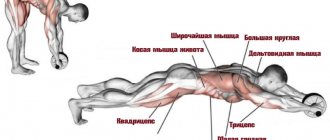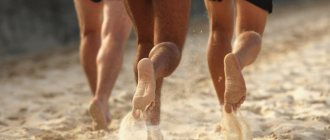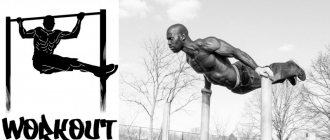Jogging or jogging is also known as an unpresentable-looking “shuffling run.” In this style, Soviet people tried to escape from heart attacks, excess weight and problems. In the USA, since the 70s of the last century, running has either become fashionable or been declared almost the cause of all the troubles of the American nation. The problem is that many people really believed that running is the only cure for heart attack, and by doing it only you can avoid excess weight. Therefore, the reputation of this type of activity has been significantly damaged by those who like to train and not keep to the regime. Running is very demanding on recovery, only then does it help to truly improve health and train the body. As for losing weight, running can be used as cardio exercise and a way to increase your calorie burn, but there is no point in trying to outrun a bad diet.
What is jogging
Jogging or jogging formally differs from regular running in pace: 7 minutes per kilometer and slower is more likely to be jogging than running. True, there is a difference in other moments: during jogging, the so-called “flight phase,” that is, the moment when both legs do not touch the ground, is minimal, but in running it increases with increasing speed.
During jogging, there is barely any forward lean angle, and it is more common to land on the heel rather than the front of the foot (although from a biomechanical point of view this is not correct). But, perhaps, the speed of jogging also depends on the physical form of a particular person and is individual for everyone. The main criterion is the sensations during this type of physical activity: when jogging, the load is low, there is no severe shortness of breath and tension in the muscles. This is the pace at which it seems that you can move forever.
Clothes for jogging
A properly selected suit plays an important role in the success of training. Running clothing must meet certain requirements:
- Promote body thermoregulation. The fabric should not stick to the body and take a long time to dry, so for running, not natural materials, but synthetic ones, which bring sweat to the surface and allow the skin to breathe, are more suitable;
- Perfect fit. Clothing should not restrict movement or fall off or twist;
- Have reflective elements on the chest and back if you plan to run in the evening or at night.
A jacket is also required for late-hour activities, regardless of the season. In the evening, the air temperature drops sharply, which can lead to a cold if you don't dress warmly enough.
Summer uniform , intended for running in hot weather, should be light and well ventilated. Tops or T-shirts, tights or shorts are suitable as outerwear. Girls also need to purchase sports bras to secure their breasts and protect them from chafing and stretching. In sunny weather, do not forget about a hat and protective skin cream.
The winter uniform should consist of several layers:
- Thermal underwear and gaiters for shin protection;
- Jumper or sweatshirt, pants;
- Jacket with hood, hat, gloves.
At the same time, when going outside in clothes, the athlete should feel cold, and after training it should not be hot. You can also create several sets for different temperatures. In addition, in winter you need to apply a rich cream to your face to avoid chapping.
Compression clothing is also available specifically for runners . Its peculiarity is that it puts pressure on the muscles in certain places. This helps eliminate incorrect leg positioning, reduce pain in the limbs and prevent swelling and venous disease. Such equipment also has good thermoregulation.
Who is jogging suitable for?
It is quite correct to say that jogging is suitable for everyone: it is useful for both beginners and experienced athletes. However, if for “experienced” runners training at a very low pace will be purely restorative in nature, for beginners it can become quite a heavy load. At the same time, you should start your journey into the world of running with jogging - after all, it is less dangerous than running, and it will be easier for a new athlete to cope with jogging than with running.
Thus, the main category of people who are suitable for jogging are beginner runners. True, jogging is no less useful for people who are at increased risk of injury: overweight people, older people or athletes recovering from injuries.
Is it possible to run with excess weight and where to start?
Choosing the optimal time for training
It is believed that the best time for jogging is early in the morning. Indeed, exercising in the morning gives a greater fat burning effect. However, the fact that each person has his own specific biological rhythms is often not taken into account.
All people can be divided into two main categories: “larks” and “night owls”. Since the main peak of activity for the former occurs in the early hours, classes from 6:00 to 9:00 are suitable for them. On the other hand, such races can overload the heart, because the body has been at rest all night. Therefore, when waking up, it is important for early risers to do morning exercises. “Owls” are more suitable for jogging from 17:00 to 21:00, when they are most active. About 6-7% of runners completely shift their training to night time.
Benefits of jogging
Jogging is a type of cycling aerobic exercise. This means that the body produces energy by oxidizing fats or carbohydrates.
marathon and half marathon training plans and start training today!
Such loads develop the cardiovascular system well: the heart muscle is trained and the vascular network improves in order to better deliver blood (and with it oxygen) to the muscles. As your training increases, shortness of breath disappears, and many everyday tasks become easier to do. The musculoskeletal system is strengthened: muscles and joints gradually develop; ligaments and tendons also adapt to the load.
Finally, jogging promotes additional calorie expenditure and, as a result, weight loss. Moreover, at this level of load, energy supply occurs mainly from fat.
The benefits of running: how running affects human health
Symptoms of body fatigue
If you do more than you need, then your body will become overloaded. At first there will be a positive result, but as the body becomes tired and, especially, as the endocrine system depletes, the positive change in health will fade away, giving way to all sorts of diseases.
A change in your resting heart rate can be a sign of overtraining. It is recommended to measure your pulse every morning before getting up. This is the normal heart rate. If the pulse is 10% higher than usual, then this can be considered a symptom of fatigue. You should reduce the load or rest for a few days.
The reasons for overtraining are too much load and insufficient intervals for the body to recover, conflict situations in the family, at work, especially shift work, sessions, etc. Provoking moments: various infections, systematic violation of the diet, smoking and alcohol abuse, weight loss. There are several phases of overtraining, but the signs are the same, only in a more pronounced form in each subsequent phase.
Signs of Overtraining
The first phase is the cessation of growth in athletic performance, irritability, touchiness, poor sleep, deterioration in health, loss of body weight, and sometimes palpitations occur.
The second phase is a more pronounced decrease in athletic performance, worse adaptation to stress after training, weakness and fatigue. Pain appears in the heart area (a feeling of compression, interruptions), as well as heaviness in the right hypochondrium. The pulse increases in a calm state. Previous diseases worsen and new ones appear.
The third phase is severe apathy, lethargy, weakness, reluctance to engage in usual sports, depression, insomnia at night and drowsiness during the day, profuse sweating, significantly worsening cardiac activity. If these signs appear, stop exercising and consult a doctor.
For running to be beneficial, it should not turn into some kind of test or torture for you, training should bring you pleasure. If you are tired from running, you can ride a bike or go to the pool, or go to the sauna with friends, lie on a massage bed, or just relax.
An indicator of a successfully found temporary training regimen is a gradual improvement in athletic performance. If the results increase, then the selected system is successful. If they stall or fall, then most likely there is a lot of load.
Cycling is an alternative to running.
If you're asking if running alone is worth it, the answer is, of course, no. There are many outdoor games and other sports disciplines, everyone chooses to their liking. But any workout begins with light running, jogging. It was started by Arthur Lydiard.
How to jog correctly
Jogging differs from regular running in that the pace is low and the flight phase is minimal. Due to the low speed, often when jogging people begin to move their hips forward and land on their heels: the lower the forward lean of the body, the more difficult it is to run with the correct technique.
However, the least damaging running technique does not change depending on the pace. Landing when jogging should be on the front surface of the foot, under the pelvis, without moving the hip forward. It is also worth remembering to respect the slope of the body in the direction of movement. But it is important to understand that bending the lower back or tilting the head forward shifts the center of gravity, so the tilt should be done with the whole body.
Contraindications to jogging
Despite all the benefits of jogging, there are contraindications to it. It is not recommended to engage in jogging if you have such diseases as:
- Varicose veins;
- Arthritis;
- Atherosclerosis;
- Heart disease;
- Hypo- and hypertension;
- Glaucoma;
- Flat feet.
Reasons for postponing training may include:
- Sprains and bruises;
- Cold;
- Exacerbation of chronic diseases;
- Recent traumatic brain injury.
Based on the goals of the training, it is worth choosing a suitable training regimen and diet. If increasing physical performance is a priority, jogging should be done over long distances, and nutrition should be nutritious, with a sufficient amount of carbohydrates. The requirements for running for weight loss are the opposite - let's say you have a calorie deficit, but you should forget about the speed and distance of the race. Before you start jogging, you should consult a doctor and, if necessary, undergo a full examination and tests.
Breathing and heart rate while jogging
Jogging does not involve strong accelerations, the body works in an aerobic mode, and this load should be felt in this way: there is practically no shortness of breath, you can calmly carry on a conversation while jogging. If you start to feel out of breath and it seems that there is not enough oxygen, you are running too fast and you need to slow down the pace or even take a step.
You should breathe through your mouth and nose, without specifically concentrating on inhalation - after all, this is a natural process that does not require awareness.
Jogging for weight loss
Since at a moderate level of exercise the body uses mainly fats for energy, jogging is an excellent way to lose weight. We described on our website how and how much you need to run to lose weight.
It is important to understand that weight loss occurs solely due to the negative delta of calories: that is, when you consume less energy than you expend. The average energy consumption of jogging is 100 kcal for 10 minutes. Therefore, by adding jogging to your daily routine, without increasing your food intake, you will lose weight. However, you should not expect immediate results. If you increase your caloric intake while jogging, weight loss will be unlikely.
How to start jogging
The main principle of starting any sport, and jogging is no exception, is the smoothness of the load. At first, the load should remain within comfortable limits. You can start with 20 minutes and gradually increase the training time, doing them every other day. If it is difficult to jog for all 20 minutes, then you can do intervals of jogging and walking, gradually lengthening the former and shortening the latter.
If running is still very difficult for you, try Nordic walking with poles at the initial stage.
Training plan for beginners
Week 1
- Monday: 5 minutes of intense walking, then alternating a minute of jogging and a minute of walking (10 repetitions).
- Wednesday: 5 minutes of vigorous walking, 2 minutes of jogging, 2 minutes of walking (5 reps).
- Friday: 5 minutes of intense walking, 2 minutes of jogging, 1 minute of walking (7 reps).
Week 2
- Monday: 5 minutes of intense walking, 3 minutes of jogging, 2 minutes of walking (5 reps).
- Wednesday: 5 minutes of vigorous walking, 4 minutes of jogging, 2 minutes of walking (4 repetitions).
- Friday: 5 minutes of intense walking, 5 minutes of jogging, 2 minutes of walking (4 repetitions).
Week 3
- Monday: 5 minutes of vigorous walking, 7 minutes of jogging, 3 minutes of walking (3 repetitions).
- Wednesday: 5 minutes of vigorous walking, 10 minutes of jogging, 3 minutes of walking (2 reps).
- Friday: 5 minutes of vigorous walking, 10 minutes of jogging, 3 minutes of walking (3 repetitions).
But, of course, we must not forget that a coach can draw up a plan that suits you individually. And the above diagram is just general advice for starting training.
You may be interested in: Health running: benefits and contraindications











